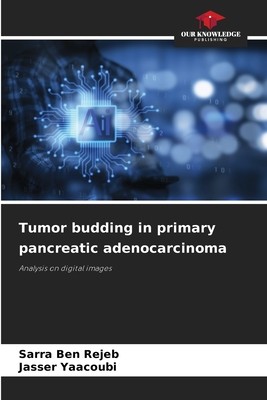
- We will send in 10–14 business days.
- Author: Sarra Ben Rejeb
- Publisher: Our Knowledge Publishing
- ISBN-10: 6208634636
- ISBN-13: 9786208634636
- Format: 15.2 x 22.9 x 0.5 cm, minkšti viršeliai
- Language: English
- SAVE -10% with code: EXTRA
Tumor budding in primary pancreatic adenocarcinoma (e-book) (used book) | bookbook.eu
Reviews
Description
Tumor budding (BT) is an emerging prognostic factor in several cancers, including pancreatic cancer. Our bi-centric study (2008-2022) aimed to evaluate BT by morphological method and with QUPATH software, and to analyze its impact on overall and event-free survival. We included 25 cases of pancreatic adenocarcinoma, with a mean age of 62 years and a male predominance (72%). BT was detected in 100% of cases morphologically and 80% by QUPATH. A high BT (BUD2/BUD3) was found in 56% of cases morphologically and 48% by QUPATH, with no significant difference between methods (p=0.589). A high BT was associated with advanced age (p=0.03) and negatively influenced overall survival (p=0.038). This study suggests that BT is a key prognostic factor and that QUPATH could become an accessible tool for standardizing its assessment in pathology.
EXTRA 10 % discount with code: EXTRA
The promotion ends in 24d.00:29:06
The discount code is valid when purchasing from 10 €. Discounts do not stack.
- Author: Sarra Ben Rejeb
- Publisher: Our Knowledge Publishing
- ISBN-10: 6208634636
- ISBN-13: 9786208634636
- Format: 15.2 x 22.9 x 0.5 cm, minkšti viršeliai
- Language: English English
Tumor budding (BT) is an emerging prognostic factor in several cancers, including pancreatic cancer. Our bi-centric study (2008-2022) aimed to evaluate BT by morphological method and with QUPATH software, and to analyze its impact on overall and event-free survival. We included 25 cases of pancreatic adenocarcinoma, with a mean age of 62 years and a male predominance (72%). BT was detected in 100% of cases morphologically and 80% by QUPATH. A high BT (BUD2/BUD3) was found in 56% of cases morphologically and 48% by QUPATH, with no significant difference between methods (p=0.589). A high BT was associated with advanced age (p=0.03) and negatively influenced overall survival (p=0.038). This study suggests that BT is a key prognostic factor and that QUPATH could become an accessible tool for standardizing its assessment in pathology.


Reviews